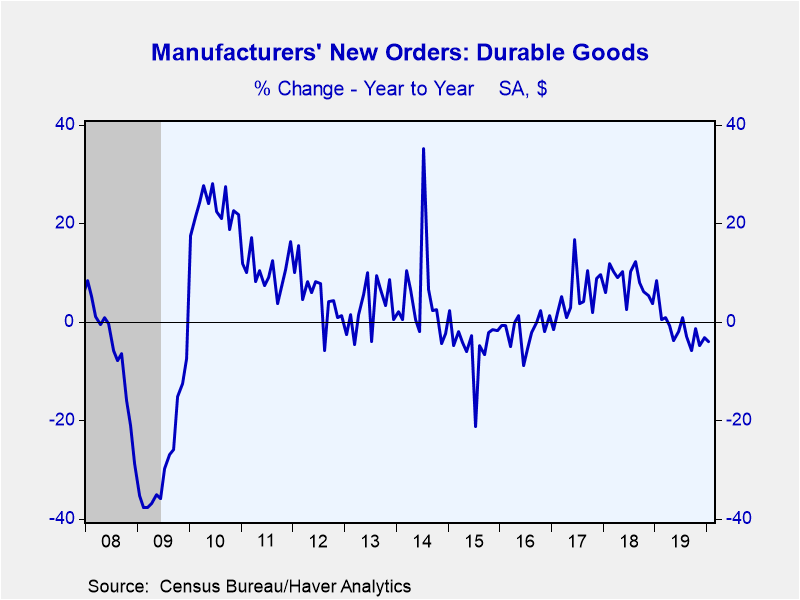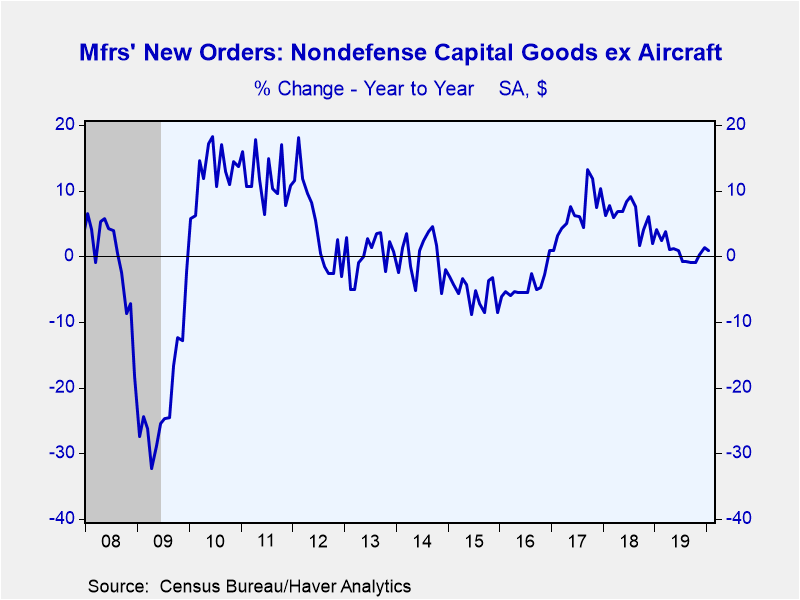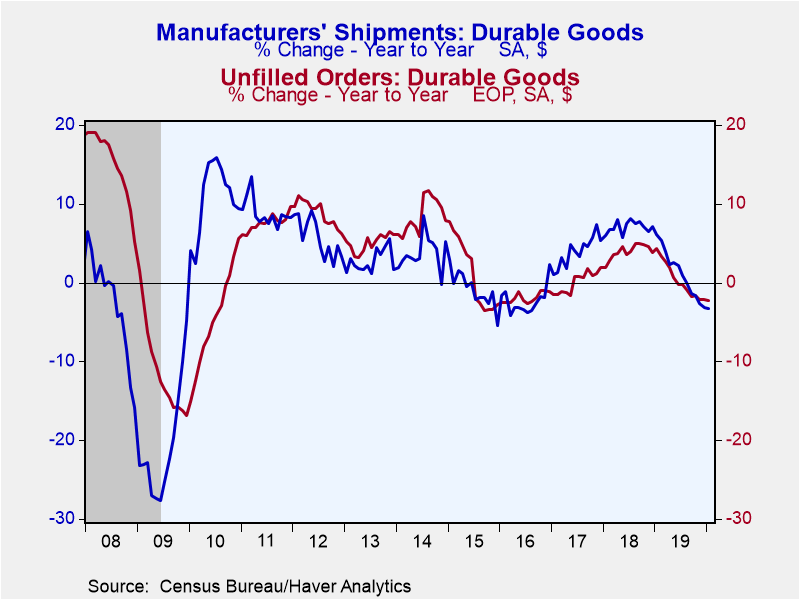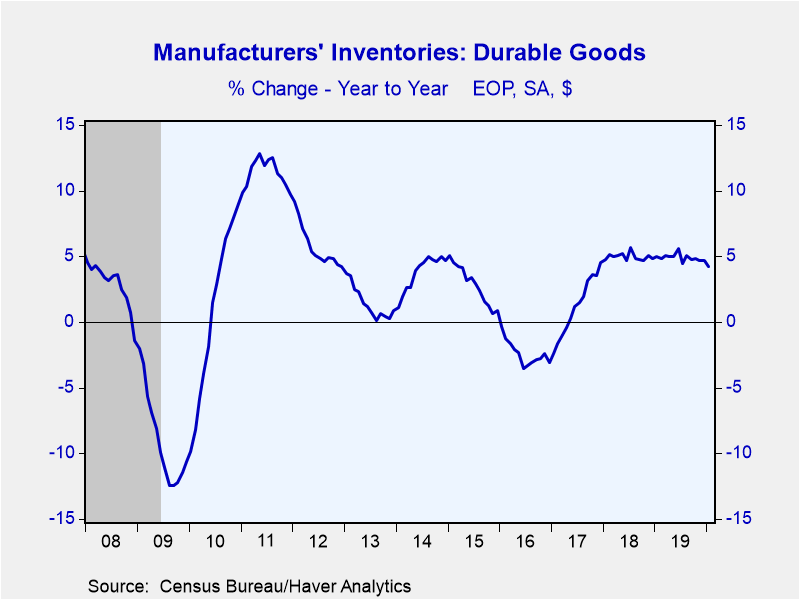 Global| Feb 27 2020
Global| Feb 27 2020Despite Monthly Decline, January U.S. Durable Goods Orders Stronger than Expected
by:Sandy Batten
|in:Economy in Brief
Summary
• Headline durable goods orders fell 0.2% in January but this was stronger than market expectations of a 0.8% m/m decline. • Weak transportation and defense orders more than accounted for the headline January decline. Excluding [...]
• Headline durable goods orders fell 0.2% in January but this was stronger than market expectations of a 0.8% m/m decline.
• Weak transportation and defense orders more than accounted for the headline January decline. Excluding transportation, orders were up 0.9% m/m. Excluding defense, they jumped 3.6% m/m.
• Core capital goods orders and shipments rebounded in January after having declined in each of the previous two months, with each rising 1.1% m/m. This put January cap goods shipments up 4.4% AR from the Q4 average.
Manufacturers' orders for durable goods fell 0.2% m/m (-3.9% y/y) in January after an upwardly revised 2.9% m/m jump in December. The stronger details/weaker headline report in January was the mirror image of the weaker details/stronger headline report in December. Transportation orders declined 2.2% m/m in January after having jumped 8.8% m/m in December. Excluding transportation, orders were up only 0.1% m/m in December but rose 0.9% m/m in January. Defense also played a major role in the December/January swing. Led by a 167% m/m surge in defense aircraft orders, total defense orders jumped 99.9% m/m in December. So, excluding defense, other orders slid 1.9% in December. In January, defense orders fell 38.2% m/m as defense aircraft declined. Excluding defense, other orders rose a solid 3.6% m/m in January.
Overall shipments fell 0.2% m/m (-3.2% y/y) in January, their seventh consecutive monthly decline. A 1.6% m/m decline in transportation shipments (motor vehicles and nondefense aircraft) accounted for the January decline. Excluding transport, other shipments were up 0.5% m/m, their first monthly increase in five months.
The most encouraging part of the January report was the performance of core capital goods orders and shipments, which each rose 1.1% m/m. Core cap goods orders/shipments are nondefense capital goods orders/shipments excluding aircraft. The January rises in core orders and core shipments were the first in three months. Core shipments figures are a reliable coincident indicator of business equipment spending in the national accounts. The 1.1% m/m January increase in core shipments put shipments up 4.4% AR from the Q4 average. Quarterly shipments, and according quarterly real business equipment spending, fell in both Q3 and Q4 last year. So, the January reading offers some optimism of a revival in business spending in 2020 Q1.
Unfilled orders for durable goods and inventories were each unchanged in January.
The durable goods figures are available in Haver's USECON database. The Action Economics consensus forecast figure is in the AS1REPNA database.
| Durable Goods NAICS Classification | Jan | Dec | Nov | Jan Y/Y % | 2019 | 2018 | 2017 |
|---|---|---|---|---|---|---|---|
| New Orders (SA, % chg) | -0.2 | 2.9 | -3.1 | -3.9 | -1.3 | 7.9 | 5.4 |
| Transportation | -2.2 | 8.8 | -8.2 | -10.6 | -4.3 | 9.8 | 3.2 |
| Total Excluding Transportation | 0.9 | 0.1 | -0.5 | -0.1 | 0.4 | 6.9 | 6.5 |
| Nondefense Capital Goods Excl. Aircraft | 1.1 | -0.5 | 0.0 | 0.9 | 0.9 | 6.0 | 6.7 |
| Shipments | -0.2 | -0.1 | -0.2 | -3.2 | 1.2 | 7.1 | 4.0 |
| Nondefense Capital Goods Excl. Aircraft | 1.1 | -0.1 | -0.4 | 0.1 | 2.1 | 6.3 | 5.6 |
| Unfilled Orders | 0.0 | 0.0 | -0.6 | -2.3 | -2.2 | 3.9 | 1.9 |
| Inventories | 0.0 | 0.4 | 0.4 | 4.2 | 4.8 | 4.8 | 4.5 |
Sandy Batten
AuthorMore in Author Profile »Sandy Batten has more than 30 years of experience analyzing industrial economies and financial markets and a wide range of experience across the financial services sector, government, and academia. Before joining Haver Analytics, Sandy was a Vice President and Senior Economist at Citibank; Senior Credit Market Analyst at CDC Investment Management, Managing Director at Bear Stearns, and Executive Director at JPMorgan. In 2008, Sandy was named the most accurate US forecaster by the National Association for Business Economics. He is a member of the New York Forecasters Club, NABE, and the American Economic Association. Prior to his time in the financial services sector, Sandy was a Research Officer at the Federal Reserve Bank of St. Louis, Senior Staff Economist on the President’s Council of Economic Advisors, Deputy Assistant Secretary for Economic Policy at the US Treasury, and Economist at the International Monetary Fund. Sandy has taught economics at St. Louis University, Denison University, and Muskingun College. He has published numerous peer-reviewed articles in a wide range of academic publications. He has a B.A. in economics from the University of Richmond and a M.A. and Ph.D. in economics from The Ohio State University.










